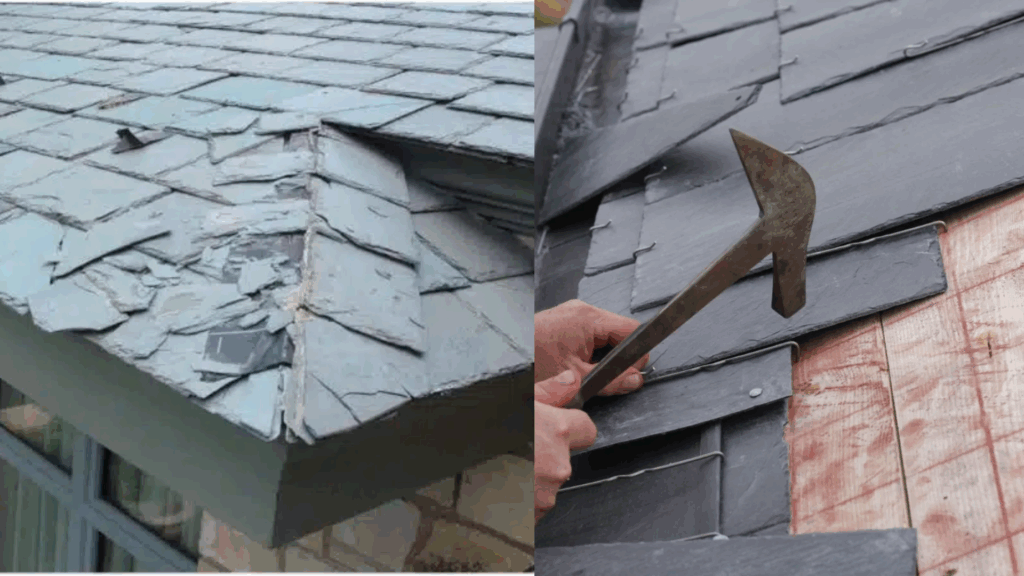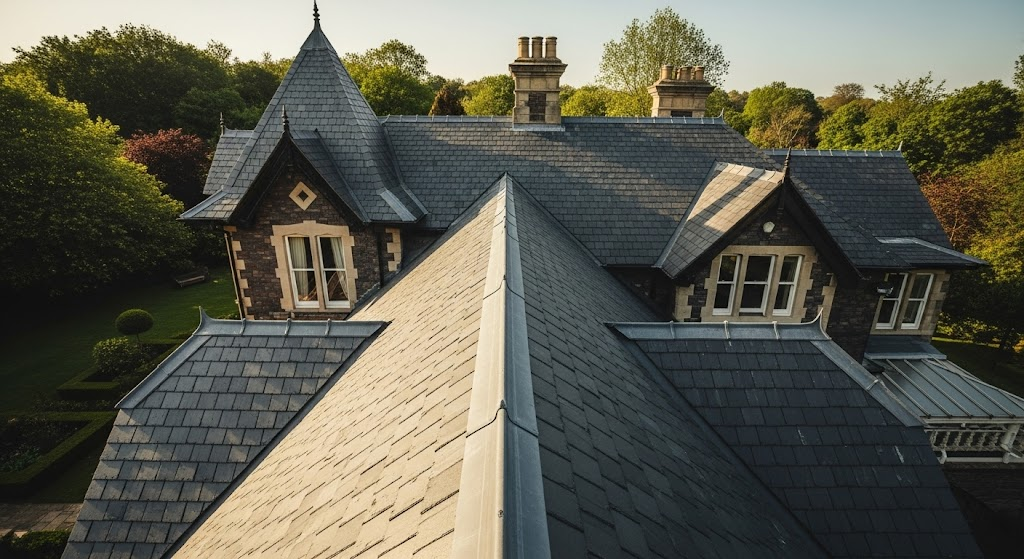When it comes to roofing materials, slate is often considered one of the most durable and long-lasting options.
Homeowners looking to install or maintain a slate roof often ask: How long can a slate roof last, and what factors influence its lifespan?
In this blog, I’ll guide you through the expected lifespan of a slate roof, the factors that can impact it, and how you can maximize its longevity.
With proper care and attention, a slate roof can provide decades of protection and beauty for your home.
By understanding the key elements that affect slate roof lifespan, you can make informed decisions about its installation, maintenance, and care.
What is Slate Roofing?
Homeowners and architects alike appreciate slate’s natural beauty and long-lasting functionality.
To create slate roofing tiles, large pieces of natural slate rock are carefully split into thin sheets, which are then shaped and installed in overlapping layers.
This technique creates a strong and weather-resistant surface that can withstand extreme conditions. Slate roofs are particularly favored in areas with harsh weather, as slate is highly resistant to fire, water, and pests.
This makes it an ideal choice for homeowners looking for a durable, low-maintenance roofing solution that not only performs well but also adds value and visual appeal to their property.
Typical Lifespan of Slate Roofs
The lifespan of a slate roof is one of its most appealing features, with these roofs often lasting for an incredibly long time.
On average, slate roofs can last anywhere from 75 to 200 years, but some exceptional cases have seen slate roofs endure for over a century or more. In fact, well-maintained slate roofs may even outlast the building structure itself.
Several factors contribute to the lifespan of a slate roof, including the quality of the slate used, the skill of the installation, and the level of maintenance.
High-quality slate tiles, when installed correctly and cared for properly, can easily reach the upper end of the lifespan range.
However, the climate also plays a significant role, as harsh weather conditions like extreme heat, rain, or freezing temperatures can impact the longevity of the slate.
Proper maintenance, including regular inspections and prompt repairs, is essential for maximizing the lifespan of a slate roof.
Factors That Influence Slate Roof Lifespan

While slate roofs are renowned for their longevity, several factors can impact how long they last.
1. Quality of Slate
The quality of the slate is a major determinant of the roof’s lifespan. High-grade slate, typically sourced from renowned quarries, is more durable and resistant to natural defects. It can last over 100 years with proper care.
Lower-grade slate, on the other hand, may wear out more quickly due to cracks or defects. Choosing high-quality slate ensures that your roof will endure for many decades, potentially outlasting the structure itself.
2. Installation Quality
The quality of installation is crucial in determining how long your slate roof lasts. Even the best slate will degrade if the installation is done improperly.
Experienced, certified roofers who understand slate’s complexities are essential for a long-lasting roof.
Poor installation techniques, such as incorrect overlapping or bad flashing, can lead to water leaks, structural damage, and a reduced lifespan, requiring costly repairs sooner than expected.
3. Climate and Weather Conditions
The climate where your home is located significantly affects the longevity of your slate roof. While slate is resistant to extreme weather, factors like freeze-thaw cycles, heavy rain, or intense heat can cause damage over time.
In colder climates, freezing water can crack the tiles, while hot climates can cause them to dry out and become brittle. Slate roofs thrive in moderate climates with minimal weather fluctuations, extending their lifespan.
4. Maintenance and Care
Regular maintenance is essential for extending the life of a slate roof. Inspections help identify and fix issues like cracked tiles, leaks, or moss buildup before they worsen.
Cleaning the roof, clearing debris from gutters, and replacing broken tiles promptly are important tasks to ensure your slate roof remains intact.
Without proper care, even the highest quality slate roof can experience reduced durability and performance over time.
5. Roof Slope and Design
The design and slope of your roof also influence the lifespan of a slate roof. Slate performs best on steep roofs because it allows rain and snow to slide off, minimizing moisture buildup.
On flat or low-slope roofs, water can accumulate, leading to potential damage. The roof’s slope can impact water runoff, so a well-designed steep roof will help prevent wear and tear, protecting the slate tiles for a longer period.
Pros and Cons of Slate Roofing
Slate roofing is a popular and durable choice for homeowners, but like any material, it comes with its pros and cons.
| Pros | Cons |
|---|---|
| Longevity: Slate roofs can last 75–200 years or more with proper care, making them a long-term investment. | High Cost: Slate roofing is one of the most expensive materials, both in terms of installation and materials. |
| Durability: Resistant to fire, water, and pests, slate roofs are incredibly durable and can withstand extreme weather conditions. | Heavy Weight: Slate is very heavy, which can require additional structural support, increasing installation costs. |
| Aesthetic Appeal: Slate offers a timeless, classic look that can enhance the aesthetic value of a home. | Installation Complexity: Installing slate requires skilled professionals, as it’s more challenging to work with compared to other materials. |
| Low Maintenance: Slate is low maintenance compared to other roofing materials, requiring fewer repairs over time. | Brittleness: While durable, slate tiles can be brittle and prone to cracking, especially under heavy impact. |
| Eco-Friendly: Slate is a natural material, making it an environmentally friendly option that’s recyclable. | Expensive Repairs: If individual tiles break, repairs can be costly and time-consuming due to the need for matching tiles. |
The Cost of Slate Roof Installation and Maintenance
The cost of installing a slate roof can be significantly higher than other roofing materials, with prices typically ranging between $10,000 and $50,000.
Several factors contribute to the cost, including the size of the roof, the quality of the slate, and the complexity of the installation.
Slate is a premium material known for its longevity and aesthetic appeal, which explains its higher initial price.
Despite the upfront investment, slate roofs offer long-term savings due to their durability and low maintenance needs. Over time, a slate roof can outlast other materials, requiring fewer repairs and replacements.
In terms of ongoing maintenance, slate roofs are generally cheaper to maintain than options like asphalt shingles.
Routine tasks such as periodic inspections, cleaning, and replacing broken tiles are usually all that’s necessary to keep the roof in optimal condition.
This combination of low maintenance and impressive durability makes slate roofs a worthwhile investment for homeowners seeking long-term performance.
How to Maximize the Lifespan of Your Slate Roof
Maximizing the lifespan of your slate roof involves regular maintenance and quick responses to problems.
- Regular Inspections: Conduct annual inspections to identify any early signs of damage, such as cracks or broken tiles, to address issues before they escalate.
- Keep the Roof Clean: Regularly clean your roof to prevent the accumulation of moss, leaves, and debris that can trap moisture and cause damage.
- Fix Problems Quickly: If you notice any issues, like loose tiles or leaks, address them immediately to prevent more severe damage and costly repairs later on.
- Remove Moss and Algae: Moss and algae retain moisture and can damage slate. Use a non-abrasive cleaner and soft brush to gently remove them, and consider installing copper or zinc strips to prevent regrowth.
- Install Proper Drainage: Keep gutters and downspouts clean and clear to ensure water flows off the roof, preventing water from pooling and causing damage.
Comparison: Natural Slate and Synthetic Slate Roofing
Natural and synthetic slate roofs both offer durability, but they have distinct characteristics and advantages.
| Feature | Natural Slate | Synthetic Slate |
|---|---|---|
| Material | Natural stone formed over centuries. | Engineered composite materials like rubber or polymers. |
| Lifespan | 100–200 years can last longer with proper care. | 50–100 years, depending on the brand and quality. |
| Durability | Extremely durable, resistant to weather, fire, and pests. | Highly durable, but may not be as resistant to extreme weather. |
| Weight | Heavier loads may require additional roof support. | Lighter, easier to install, and doesn’t require extra support. |
| Cost | Expensive, typically $10,000–$50,000+ for installation. | More affordable, usually 40–50% less than natural slate. |
| Aesthetic | Offers a timeless, authentic appearance. | Mimics the look of natural slate but may not match the original perfectly. |
| Maintenance | Requires less frequent maintenance but may need repair due to cracking. | Easier to maintain but may degrade faster over time. |
| Installation | Complex, requires skilled professionals. | Easier and faster installation process, often DIY-friendly. |
Conclusion
A slate roof is a long-term investment, offering exceptional durability and beauty that can last over 100 years with the right care.
Understanding the factors that influence its lifespan, such as installation, climate, and maintenance, will help you maximize its longevity and protect your home.
If you’re considering installing a slate roof or need guidance on maintaining your current one, it’s essential to work with experienced professionals to ensure the job is done right.
Regular inspections and proper care will ensure your slate roof performs for generations to come.
I highly recommend reaching out to a professional roofer for advice or assistance if you’re thinking of installing a slate roof or need help maintaining your existing roof.

